Introduction: In this article, Mary Harrell-Sesniak searches old newspapers to learn about how our ancestors regarded the marriage of cousins. Mary is a genealogist, author and editor with a strong technology background.
Most people don’t marry close relations, but sometimes while tracing ancestry you might observe cousins that married close cousins. Being naturally curious about this practice, I decided to look back 100 years or more to see what people thought about married cousins.
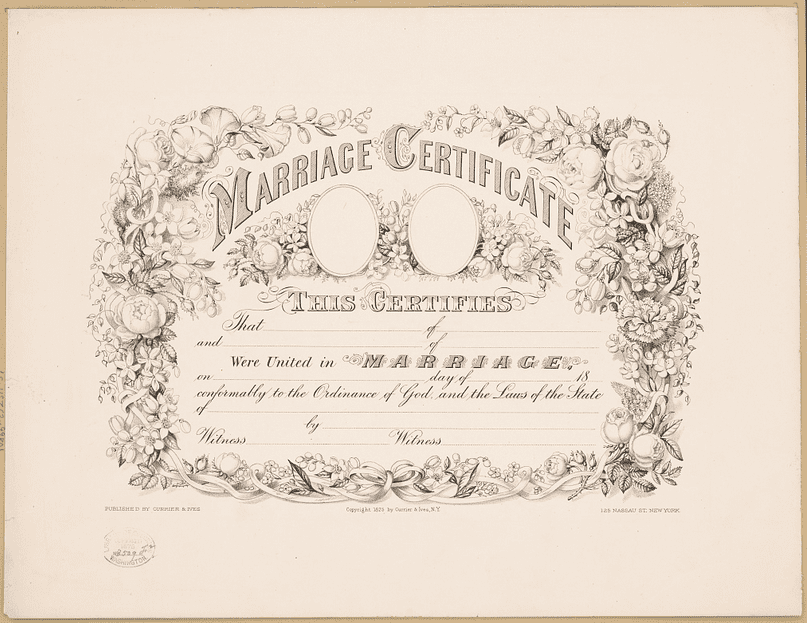
What did I find? Most of the answers came from questions posed to advice columnists.
In many places it was against the law for cousins to marry, but not everywhere. Some of the supporting reasons for or against the practice were interesting – and others, somewhat amusing.
Responses to the question: Should Cousins Marry?
1907
In 1907, I found an article written by an eminent, but unnamed, German specialist.
He addressed the theory that marriages between blood relations produced unhealthy children – and concluded that the various laws prohibiting unions between alcoholics, as well as those with tuberculosis and deafness, were more important than laws prohibiting marriage between close cousins.
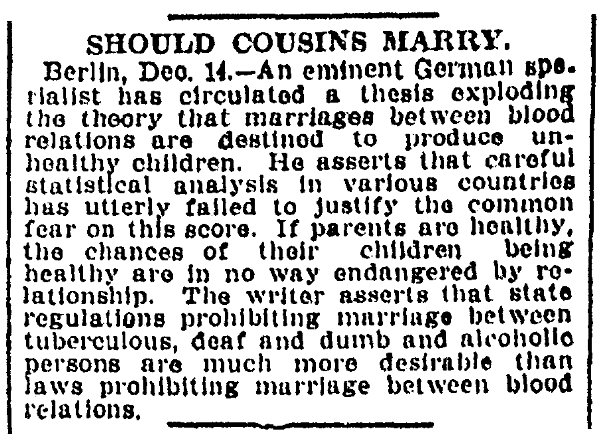
1910
Mrs. Adams, whose advice column ran across the country in 1910, felt it was not advisable for persons so closely related as first cousins to marry. However, in the end she preferred not to solve the perplexing problem because it was a frequent practice.
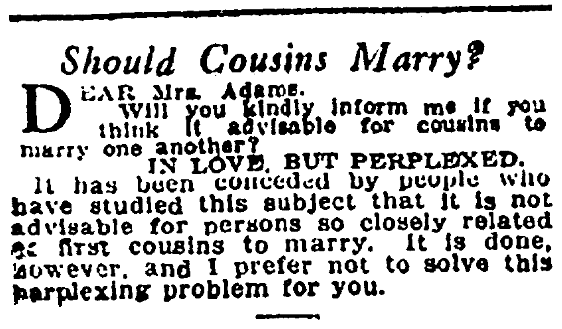
1912
In her advice column “Heart and Home Problems,” Mrs. Elizabeth Thompson of the Daily Illinois State Register addressed the concerns of a 17-year-old who was engaged to her much older second cousin, who was 30.
Her opinion was that first cousins should never marry, and that it was not advisable for second cousins to do so either. You may enjoy reading the clip as she also added a tasty recipe to her response.

1914
In 1914, a column titled “Advice to the Lovelorn” addressed the question, “Should Cousins Marry?”
Doris Blake wrote:
“Sometimes the answer is given by the law. In many states the marriage of first cousins is illegal. True, this law may be evaded by having the wedding ceremony performed in another state but there are unpleasant complications about the children…
“The marriage of cousins is less a question of right and wrong than of expedience. The close blood ties is inadvisable, if not dangerous. Such a marriage may turn out all right and – IT MAY NOT! It is taking great chance and my advice is nip sentiment with your cousin in the bud lest it bloom unhappily.”
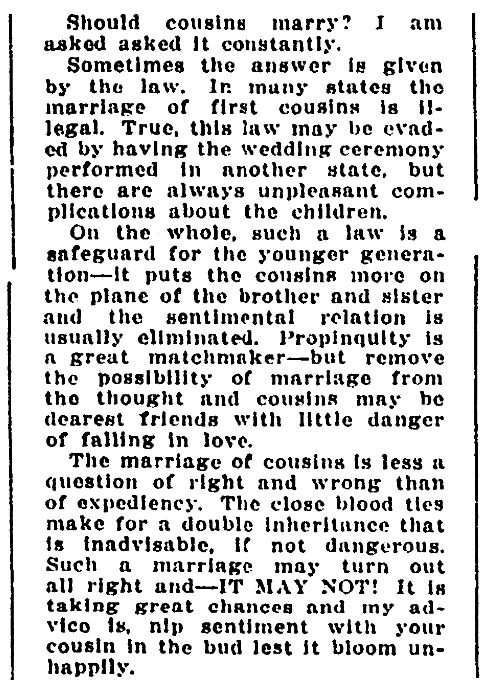
1915
A complicated story was reported in 1915.
Two cousins had met and married without knowing that they were related. They had the same surname, but hadn’t realized their fathers were brothers because they were estranged. This column noted that the district attorney would let her know the legality of the marriage the next day. I was unable to find the answer to this question, so I’m thinking the couple may have left town or divorced quietly.
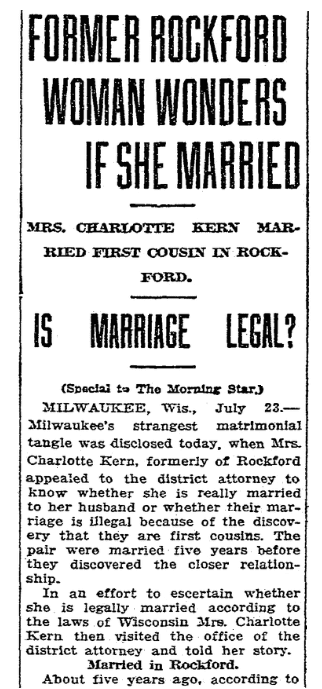
1916
From a practical standpoint, one young lady joined a discussion in 1916 and said it was a matter of economics. After all, if two of your cousins marry, you’ll only have to purchase one wedding present whereas you’d otherwise have to buy two!
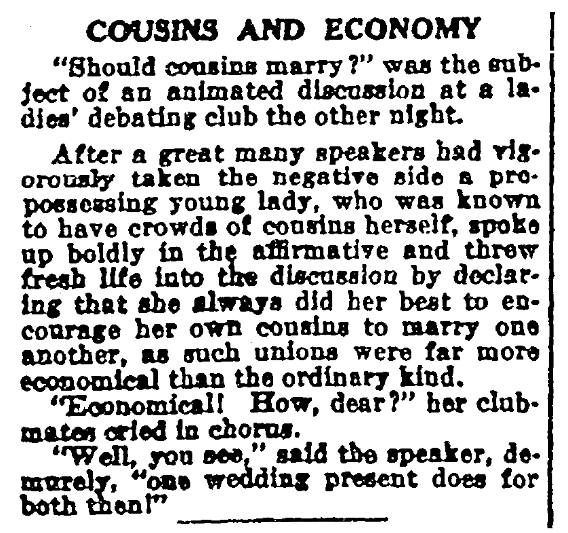
1919
Wonder if the medical community would give the same advice as Doctor William Brady gave in 1919?
He felt that if there were no hereditary defects in the family, then go ahead. However, if there was alcoholism, epilepsy, insanity or the like, the chance of having defective offspring doubled.
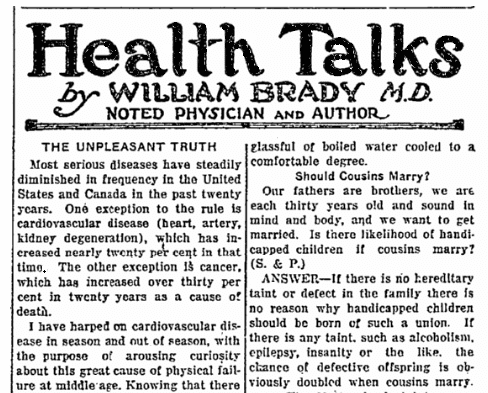
1920
Doctor Brady addressed the question again in 1920. His follow-up response suggested that marrying for love was nonsense as “love is an imaginary state.”
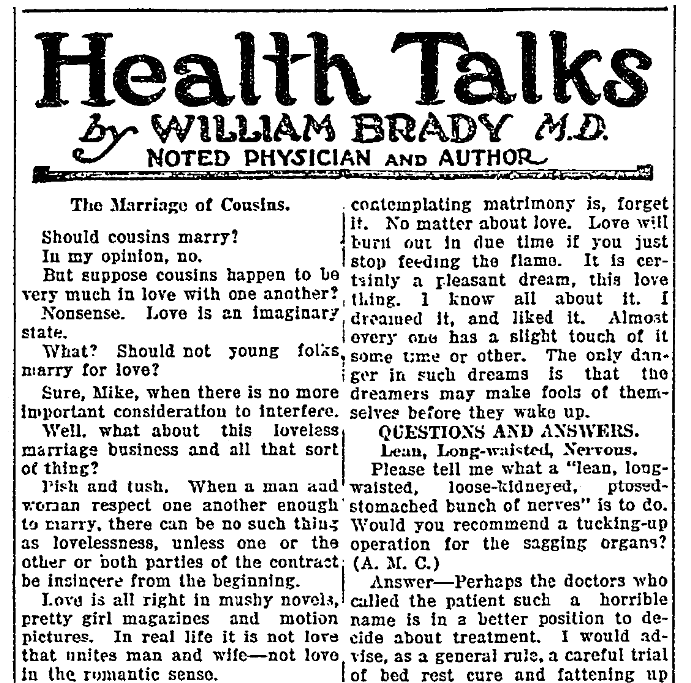
Are there any cousin marriages in your lineage? In my ancestry, I have not found cases of first cousins marrying, but there are a number of old examples of second cousin unions. One bit of lore that came through the family suggested it was acceptable due to religion. Use the comments section below to tell us what you have found about your family.

Cousin marriage was customary for centuries before the time period you specify — among royalty and the wealthy, it was practically required for the purpose of keeping money and property from being diluted by the addition of new bloodlines. Acceptance of Darwin’s theories in the late 19th century (some of which have actually been proved wrong) was the major cause of the shift reflected in the 20th-century sources you have cited, along with more advanced methods of transportation that led to increased ability to seek mates outside the immediate community where one was born and raised.
Nancy,
Thank you for writing. I would agree that for certain classes of society it was quite common.
Mary
In early 1800s the practice was inevitable in the small communities in the frontier. Choices of mates/financial support were limited many times to the community or near communities, which had traveled and settled together, which usually meant relatives.
One such group moved from Maryland to Kentucky, show many 1st and 2nd cousin marriages. Of personal knowledge one such union of 1st cousins in early 1900s married and after several children, were asked to separate because of the close relationship. Of course they never did.
Medically speaking, the abundance of inter-family marriages had some inevitable show of problems with heart problems and early death among the males of the family community.
With the advent of easier modes of transportation, these situations may occur less frequently as people are exposed to more opportunities.
The social and economic environment have a great influence on the practice of intermarriage.
Thank you for your comments.
Mary
My Great Grandmother, born 1859 in Bavaria, was the 4th illegitimate child of her parents -– according to church records. Turns out they were given permission to marry after this 4th child. The church would not permit their marriage prior to this, as the parents were indeed first cousins. She probably traveled from that village to the U.S. in hopes of escaping that stigma, only to have me uncover it 150 years later!
In my ancestry, there are a lot of cousin marriages!
In one case, John Irvin & family were the first White family in Campbell County, Virginia. They came from Pennsylvania with their household including slaves. The options of whom to marry came down to Indians who wanted to kill them, their slaves, or EACH OTHER. They “Each Other-ed” each other to death!
John (1)’s son Matthew had a son, John (2). His brother William had a daughter, Margaret, who married cousin John (2).
He (John 2) had 5 children by 2 wives. Oddly, they were both named Mary Ann and maiden initial S… that took us on a merry chase for YEARS before discovering that there were 2; having found Mary Ann Steele Irvin dead and buried in Virginia, leaving widower John and 2 sons, Alexander and Robert Steele Irvin… and then in the next census “they” were both alive having children in Tennessee, (including a great grandmother, Sarah Fairfax Irvin). There was our elusive Mary Ann S. Irvin with the same husband and the same 2 older boys!! FINALLY we found in Appomattox County (used to be part of Campbell) John Irvin marrying Mary Ann SANGSTER! Her family goes back to the Fairfaxes of Virginia and explains Gramma’s middle name!! Ms. Sangster was mother of Tommy, Ida, Roberta and Gramma Sallie!
There are many other cousin marriages, to the point I had to chart them out on a posterboard: Irvin, Steele, Chapman, Bond, Bryan, and a few single marriages, but most inter-familial ones.
Then formerly-unrelated people married into one another’s family, with a string of siblings married to brothers and sisters of one other family… making double-first cousins. Most of them are on Mother’s lines. 3 of the original John (1) Irvin’s daughters married McElroy brothers and went to Kentucky (and intermarried more there).
As late as 1904 when my maternal grandparents (Ben & Minnie) married, soon after, his sister Hariett married a first cousin of Minnie’s: Samuel Buford Wilson.*
Then Ben and Mary’s brother John married her cousin Florence*, who was Samuel B. Wilson’s brother. THAT created children who were one and the same first and second cousins to my mother and her siblings, and to each other!
Climbing back up the family tree, there was a Richard Buford (Beaufort) who came to Charleston in the 1600s. He is the lineal ancestor of all those cousins.
My grandmother’s grandmother was Mary Buford… and her cousins Florence and Sam Wilson’s mother was Leona Buford!
AND then Aunt Mary (Ben, John & Harriett’s sister) married Henry Tomlindson Buford (Bufe), who was second cousin of Florence and Sam (his father was Lenora’s brother). Mary & “Bufe”’s son Paul, an only child, has no children.
I hope this is not too confusing! It has taken me since 1993 to get it to this point. My grandmother gave me a good start on it in 1961, which I put away “until I had time,” i.e., retired.
Florence and John had no children.
Harriett and Sam had 4. Her daughters died young with Harriett having only one son, Evelyn none. Their son Billy died of Hodgkin’s disease without offspring. The other son lived 4 years with Hydrocephalus.**
Ben & Minnie had 8 children. The oldest and twins (#s 1, 6 & 7) died within days of their birth. Of the other 5, all seemed OK except my mother (b. 1912) had one extra lumbar vertebrae. Then I was born in 1941 with Spina Bifida. These may be flukes, BUT all are Neural Tube Defects, and I attribute it to the possibility of too many early cousin marriages, and I have many found in the families in Londonderry (Boyd, Irvin, Wylie, Bryan).
In 1999 we found that my granddaughter has Barts Hemoglobin, a blood disorder akin to Sickle Cell Anemia. This is a thalassemia minor. All it means to us is lifelong anemia and resistant to iron in foods or supplements. Testing showed I and my daughter also have it, and my endocrinologist said it is usually passed straight down the maternal line… so I have to go before Buford to Ragsdale and Corbin and before, to pin down the source. I am in correspondence with cousins checking to see who else may have been affected with Barts.
I have the family lines all back to the immigration to the Colonies. The most RECENT is 1745; the earliest is Edward Doty on the Mayflower.
Florence and Sam Wilson’s mother was Leona Buford.
Yes, genealogy should be searched before looking for your mate. I met my wife in a dept. store, I ask her what church she went to, and she said her family were all Quakers. After we had been married over twenty years, we got into the research of ancestors. Our third child had problems with her joints and missing finger nails, and the doctor did not know what caused this problem. We found my wife, her mother and father had the same fourth great grandparent as me, so kept searching our ancestry for this problem with our third child. Well, now we have found we come from 15 of the same early families of America. I found my mother also was of Quaker background. This I did not know about for over twenty years of marriage. My oldest brother started researching in Salt Lake after 1970, and he said my wife and I were related. After twenty years it was too late to change things. Our third child has seen problems with her children, and grandchildren. It looks like too many cousins in our family lines. My two brothers can’t have children.
Eugene,
Thank you for writing. I am sorry to hear about your family health problems.
You make a valid point, even when the cousin relationship is distant. Although extremely rare, it’s possible for two parents to share genes that cause issues.
However, rather than look at a particular ancestral link, try discussing genetic and environmental testing with your physician. You might learn that the cause is not what you suspect.
Mary
My paternal grandparents were first cousins and my father (an only child) was born with a cleft pallet and hare lip. My children are fine.
Arlene,
Thank you for writing and sharing your thoughts.
Mary
It appears that my great grandparents (my father’s grandparents on his father’s side) were double first cousins as their fathers were brothers that married sisters. Their children then married. My father’s great grandparents on his mother’s side were first cousins. As stated, on the VA/TN frontier, there was little choice. There are no defects that I have found. In fact, most of them led very long (nearly to 100 years of age in most cases), very healthy lives.